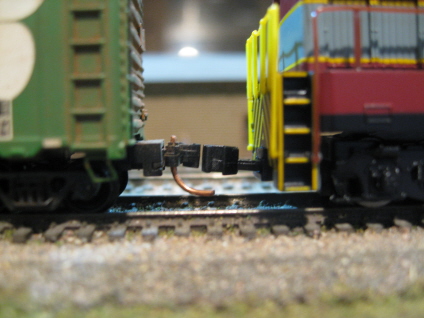

Introduced: 2006
This model (along with their simultaneously released B23-7/B30-7 model) appears to be Bachmann's effort to introduce a new strata of quality and pricing to N scale. The detailing and performance are clearly head and shoulders above the "cheapie trainset crap" locos for which Bachmann has been famous (at least in their non-Spectrum line). And although not quite up to the level of quality that we see from the high-end manufacturers like Atlas and Kato, the pricing on these models is quite reasonable, no doubt making them attractive to modelers who aren't quite as fussy as their rivet-counting brethren.
The chassis is all metal, split-frame and decently hefty for its size. The fuel tank is simply painted onto the chassis. The motor is a closed-sided 3-poler. There are no flywheels. All wheels provide pickup (no traction tires), with current transferred to the chassis by way of bronze wipers on the trucks. All wheels are geared and all gearing is plastic. A DCC-Friendly PC board on top of the chassis controls LED directional lighting. Couplers are shell-mounted. Wheels are blackened and low-profile.
Despite their similarities, this model's chassis is not exactly the same as the one used in the B30-7 (this one being a bit shorter).
Like other Bachmann diesels of similar vintage, these models are at least "DCC Friendly" (if not out and out "DCC Ready"). There is no simple drop-in decoder option, but they do have a removeable weight where one could place a decoder, as well as having solderable contacts on the lightboard for DCC wiring.
Out of the box, these locos come with one-piece knuckle couplers (Rapidos are also included should you want to switch). I have read various complaints about the height of the stock knuckle couplers being somewhat "off". However, I'm having a hard time seeing the problem myself. If it's off, it's certainly not off by enough to impact operations -

According to the Micro-Trains website, installing MT couplers in these models is not an entirely straightforward operation -
"You need to perform surgery to get the couplers to sit right. I removed the Draft Gear Box and trimmed down the pilot platform face and the boss supports (screw posts) about .050". Once I had it nice and flat using an Xacto, I reattached the platform part of the Draft Gear box with the two screws. Then I attached the 2004-1 to the platform. That gets you pretty close. I suspect the enterprising modeler could glue a block of Evergreen Styrene to the back of the Boss Supports and drill a hole there without doing too much trimming".
Mine runs very nicely - smooth, quiet, and responsive at all throttle levels. Slow speed creep is outstanding, as is the pickup. Pulling power is decent. In fact, apart from the very high top end speed (which has never been a big concern for me anyway), I can't really find any flaws with the way this model runs. The looks are quite respectable as well, with sharp paint and nice, skinny handrails. Sure, if you do a side-by-side comparison with an Atlas H16-44, you're going to see plenty of minor differences in the detailing and proportions. But again, if you're not a big time rivet-counter, it's probably not going to worry you too much.
Overall, a very respectable model. And given the relatively low price, one that should be able to find some sort of niche in the N scale locomotive pantheon.
To remove the shell, use a couple of toothpicks (or small screwdrivers or whatever) to pry the shell away from the chassis. It should lift up and off at that point (with maybe just a little finagling).
Grade: A